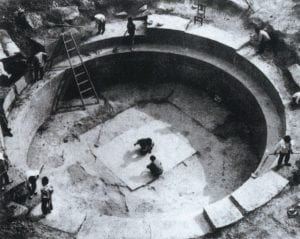Dear all,
We are excited to announce our fifth and last workshop of the fall quarter, taking place Wednesday, November 29, from 4:45-6:45pm CT at CWAC 152. This event will be featuring:
Sijia Huo
Visiting PhD Candidate, UChicago
National Institute for Advanced Humanistic Studies, Fudan University
Who will be presenting on:
“The Materiality and Spatial Context of the Tiantang Colossal Buddha Statue in Luoyang in the Late 7th Century”
Discussant: Wei-Cheng Lin
Associate Professor of Art History and the College, UChicago
For those who are joining on Zoom, please register at this link (password: 000000). Please see below for the abstract and bio for Sijia’s presentation.
Let’s finish the quarter strong and we ~Hope to see you there!~
Yours,
Alan & Yan

Image: Archaeological fieldwork at the central pit of Tiantang in the 1970s
Abstract
Not long before Wu Zetian officially ascended the throne, a magnificent building called “Tiantang” was built in the Palatine City of Luoyang, in which a colossal Buddha statue was placed. This colossus existed for only a few years before being completely destroyed by a fire. Although there are some relative historical records and archaeological evidence, it is still a challenge to depict such an object that could no longer be accessed physically. One of the most thorough previous historical studies is from Antonino Forte. After scrutinizing the text resources in detail, he proposed that the “Tiantang” was an essential part of the “Mingtang” complex, and explained its significance as a Buddhist utopia. At the time he was conducting his research, the archaeological report on the site of “Tiantang” had not yet been published. With great respect to Forte’s extraordinary work, this paper will focus on the materiality and spatial context to further explore the various details during the construction process of the colossal statue and the architecture. I contend that the colossal hollow dry lacquer statue was made in parts, and then assembled in Tiantang with the support from the central pillar structure. In this way, the designer of Tiantang succeeded in integrating a colossal Buddha statue with a great tower. By examining the relationship of Tiantang, Wucheng Hall and Mingtang, it can be concluded that Wu Zetian created a completely new ruling space for herself. On the basis of these analysis, we may expect to clarify the differences between the discourse presented in historical records and the practice of making the statue and surrounding complex.
Bio
Sijia Huo is a PhD candidate of National Institute for Advanced Humanistic Studies, Fudan University. Her research interests include Buddhist art and stone inscriptions in medieval China. She is working on her PhD dissertation about colossal Buddha statues in the Tang Dynasty.
Wei-Cheng Lin teaches in the Department of Art History at the University of Chicago. He specializes in the history of Chinese art and architecture with a focus on medieval periods. His primary interests of research are visual and material cultural issues in Buddhist art and architecture and China’s funerary practice through history. He is the author of Building a Sacred Mountain: The Buddhist Architecture of China’s Mount Wutai, published by the University of Washington Press in 2014. He has additionally published on a variety of topics, including collecting history, photography and architecture, historiography of Chinese architectural history, and contemporary Chinese art.